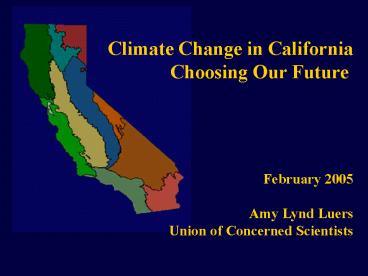Climate Change - PowerPoint PPT Presentation
1 / 16
Title: Climate Change
1
Climate Change in CaliforniaChoosing Our Future
February 2005 Amy Lynd Luers Union of
Concerned Scientists
2
Global Mean Surface Temperatures Are Rising
Deviations from mean temperature (C) from
1961-1990
The time series shows the combined global land
and marine surface temperature record from 1856
to 2001. Data from Jones et al., 1998 and from
the Climate Research Unit at the University of
East Anglia (www.cru.uea.ac.uk compilation by
Phil Jones).
3
Human Factors Affect Earths Energy Balance
- Burning Fossil Fuels
- - Deforestation
4
Scientific Consensus
There is new and stronger evidence that most
of the warming observed over the last 50 years is
attributable to human activities. (Intergovernme
ntal Panel on Climate Change (IPCC) 2001)
5
What Can Californians Expect in the Future?
- Depends on what we do today
6
Assessing Consequences of Inaction
Sept 13 2004
August 16 2004
7
Global Emissions ScenariosIntergovernmental
Panel on Climate Change (IPCC)
1000 ppm
550 ppm
8
Rising TemperaturesCalifornia statewide
Projected average summer temperature changes
9
Increasing Heatwaves
Additional heatwave days/years in 2090sOver
1961-1990 reference period
of Additional heatwave days
Los Angeles
San Francisco
Sacramento
Lower emissions scenario range (dark green PCM
model and light green Additional days projected
in HADCM3 model
Higher emissions scenario range (red PCM model
and Orange Additional days projected in HADCM3
model
10
Precipitation ProjectionsStatewide, Winter
HAD higher
PCM higher
HAD lower
PCM lower
0
11
Diminishing Sierra Snowpack Remaining, Relative
to 1961-1990
Higher Emissions
Lower Emissions
12
Impacts on Water Supply
Three types of water storage
Snowpack
Constructed Reservoirs
Groundwater
13
California Climate Projections Summary End of
Century
- Higher emissions yield higher summer temperatures
- Higher scenario summer 9 to 18 F
- Lower scenario summer 4 to 9 F
- Heat waves 2-5 times more common, more intense,
and longer lasting - Sierra snowpack loss
- 70-90 in higher scenario and
- 30-70 lower scenario
14
Managing Climate Change in California
- Reduce emissions of heat-trapping gases
- Transportation accounts for 49 of C02 emissions
- Electricity accounts for 30 of C02 emissions
- Minimize pressures on the environment
- reduce fire risk in forests
- Protect natural floodways
- Reduce encroachment on sensitive ecosystems
- Prepare for climatic changes that
- cannot be avoided
- Heat warning system
- Water conservation
15
(No Transcript)
16
(No Transcript)































